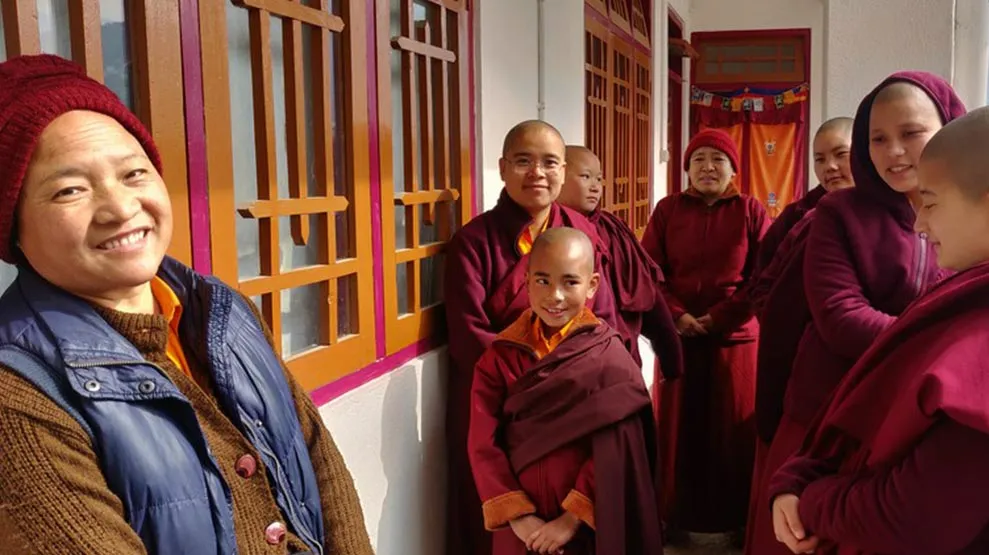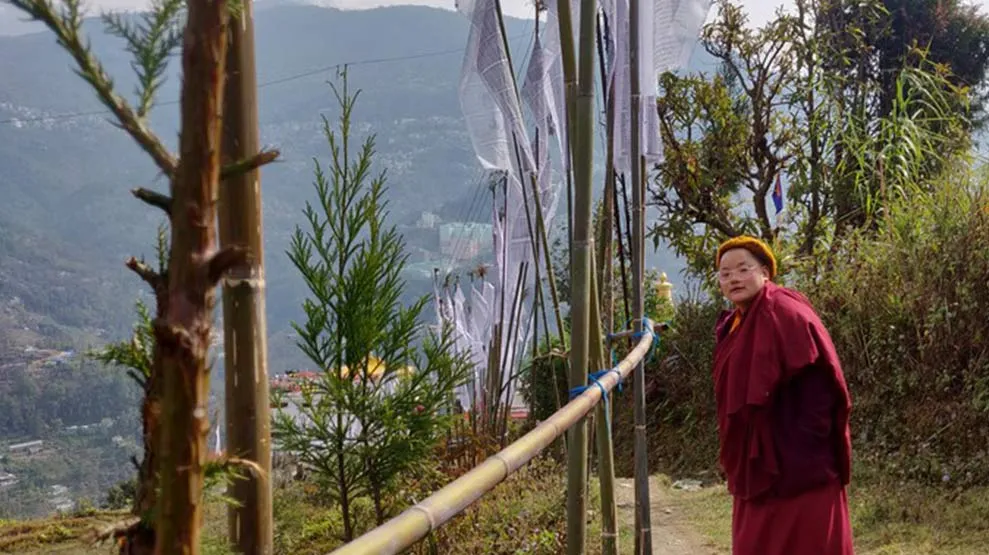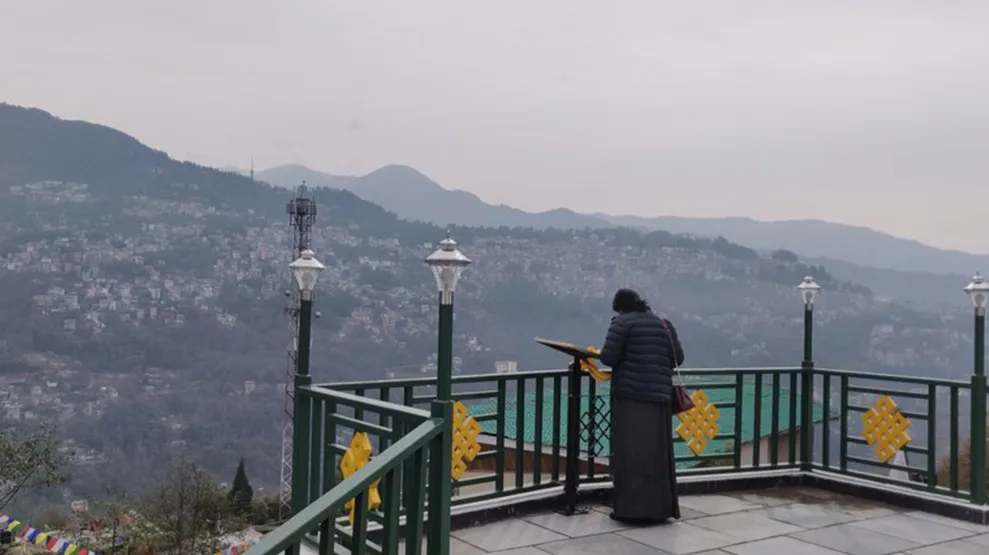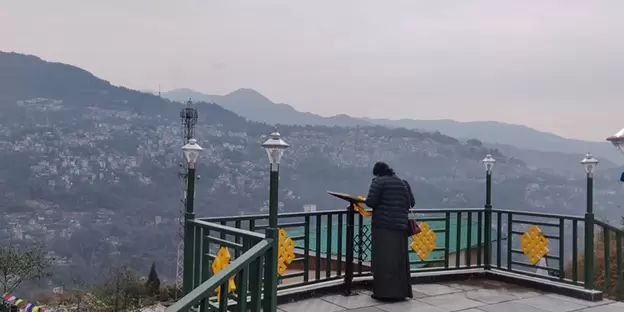


Tenzing, a young nun in her early twenties wakes up every morning at 4 am to start her prayers. She used to go to school earlier but left it to join the Ani Gumpa Nunnery in Gangtok at Ranka. She has been there for six years since. “It’s a choice we make to find peace & devotion and that’s what makes this Gumpa different to other monasteries”, says Tenzing. There are 27 other nuns who live in the Gumpa, the youngest being 9 years old and the eldest above 60 years. Most of them come there to leave their worldly desires and live a life of solitude and prayers, finding peace in the sisterhood of their fellow nuns

Khachoed Pema Woeling Nunnery (or Ani Gumpa Nunnery as is called locally) was established in 2006 by the most venerable Khamtul Jigme Thinley Lhundup Rinpoche (1922 – 2016). As per Rinpoche’s vision, the nunnery is dedicated to the practice of Dudjom Tersar – “The New Treasures of Dudjom”. Dudjom Tersar is a collection of ‘TERMAS’ (Treasures) revealed by Dudjom Lingpa (1835 – 1904) and his Holiness Dudjom Rinpoche (1904 – 1987). In 2011, H.E. DUNGSE THINLEY NORBU RINPOCHE designated the nunnery as the main Dudjom Tersar Center in Sikkim.
Ani Gumpa Nunnery is setup on the outskirts of Gangtok city. A beautiful drive from Gangtok takes you through curvaceous roads, small waterfalls, pristine greenery and a countryside surrounding which comes to life in the rainy weather. Recently the venerable Dzongsar Jamyang Khyentse Rinpoche inaugurated the newly built stupa at the Nunnery. The stupa is bell shaped which represents the female form. “I have found that in Sikkim when people get involved it really helps. Sikkim is a generous community”, says Kunzang Chungyalpa, the general secretary of the Nunnery. “For the recent stupa inauguration, we received a lot of help from the local community, including many of our practitioners, older ladies.”

The Gumpa does not accept donations from abroad. The philosophy is to get the local community involved. “We have to look inwards, within our own community. After many years, especially for the building of the Stupa, the local community has really helped, the elder ladies especially”, says Kunzang. The nuns are not encouraged to travel to people’s homes to offer prayers. They do not travel to Gangtok for Shapten (Prayers) but they do go to the local homes around Ranka for offering prayers. Local community involvement is very important to them. “If you are here, and we do not offer services, there is no point.” Many older women from the local community come to the nunnery with vegetables and stay with them for a few days. “In the future, the way forward maybe for smaller localized monasteries to come up and cater to their respective local communities” says Kunzang.

Miss Kunzang taps into central and state schemes to help run and develop the Nunnery. Apart from this, local organisations and well wishers also contribute whenever they can. “Last time I got a ministry project, I had 50 windows repaired”, she says with a satisfied giggle. For a monastery that is focused mostly on meditation and not so much on travel, it has limited needs and hence more easy to sustain. Once a year, the nuns travel for pilgrimage to Bodhgaya and other religious places for a short one or two day visit. There are many local sponsors who sponsor the nuns at the Nunnery. Locals are also encouraged to come to the monastery to offer Shaptens (prayers) for special occasions. A new wing is coming up at the monastery where guests, who are looking for some spiritual/ meditation retreat, can come and stay and can offer some donation to the nunnery.
When he came to the Nunnery, venerable Dzongsar Jamyang Khyentse Rinpoche advised them to reach out to more young people and also to teach English at the Nunnery. Luckily, one of the nuns who joined them recently was a teacher and so she teaches English to the other nuns there. Many of them also grow vegetables in the fields above the monastery near the meditation retreat. The meditation retreat or “Tshamkhang” is where nuns meditate for 3 years, 3 months, 3 weeks and 3 days to attain a higher level of learning. Only one nun visits them daily to give food and water. Ladies of all ages and religions are welcome to join the monastery when they “feel their calling”. There are some from Darjeeling, Kalimpong and many from Bhutan too. Whenever anyone wishes to join the nunnery, the head monk (Khempola) explains to her the kind of lifestyle she will be leading at the nunnery. Then he sends them back home to think about it and reflect and if they still feel they want to join the monastery, they are most welcome there.
There are very few female Rinpoches in Tibetan Buddhism and for a nun to attain full monkhood, it is very difficult. Tibetan lineage for Gelongmas (bhikshuni – the fully ordained monk/nun) is broken and efforts are being made to revive it but there is a lot of controversy. The traditional monastic systems are just opening up to having women. Women who are religiously inclined need to have the empowerment to practice formally. The female nuns’ education and training establishment has been weaker in Tibetan Buddhism. Our Grandmothers have always practiced on the fringes of the monastery, themselves learning the teachings and practices on their own. In most families in Sikkim, it is the women who are at the forefront of pushing the Dharma and ensuring that the religious traditions are followed at home. Sikkim is very well known for our Gnyamo Anas (Older Mothers). Once the mother of the family has fulfilled her duties, gotten her children married and settled, many of them take time out to visit the local monastery for meditation and prayers.

There is only one phone at the nunnery which the nuns use sometimes to communicate with their families. But most of them have found their families at the nunnery – praying together, growing vegetables together, cracking jokes, cooking and leading a simple life where the currency of peace and harmony are in abundance.“In this age, training one educated nun is worth training 20 monks”, Miss Kunzang says as she leaves us with a radiant smile, to begin her rounds of the nunnery and continue her developmental work.

Written by Karma Thutop Chechutharpa: Bridging Cultures Through Travel
Karma, a seasoned traveler with a deep love for Sikkim's rural charm, returned home in 2017. Co-founding OurGuest, he leverages his experiences across India, Nepal, and Bhutan to curate authentic travel journeys. Beyond adventure, Karma champions rural tourism. Through OurGuest's stories, he empowers local homestays and fulfills his childhood dream of becoming a writer, all while sharing the magic of Northeast India.
For a customized Offbeat Sikkim tour experience you can contact us at +91-7669503993 or email to contact@ourguest.in




